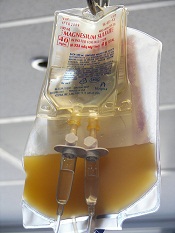User login

The AABB has developed new guidelines that specify situations
in which adults should receive platelet transfusions.
The group’s
recommendations are based on results of a systematic review.
The
suggestions cover several clinical situations in which platelet
transfusions might be an option, such as therapy-induced hypoproliferative thrombocytopenia, central venous catheter placement, diagnostic lumbar puncture, and cardiac surgery.
To formulate the guidelines, researchers conducted a review of randomized clinical trials and observational studies published from 1900 through September 2014. All studies reported clinical outcomes in patients receiving prophylactic or therapeutic platelet transfusions.
Based on the collected data, the AABB now strongly recommends prophylactic platelet transfusions to reduce the risk for spontaneous bleeding in hospitalized adults with therapy-induced hypoproliferative thrombocytopenia and a platelet count of 10 x 109 cells/L or less. The recommendation states that transfusing 0.5 to 1 apheresis unit is sufficient in these patients.
A weaker recommendation is that prophylactic platelet transfusions be given to patients undergoing elective central venous catheter placement who have a platelet count of less than 20 x 109 cells/L.
Likewise, the AABB says prophylactic transfusions should be given to patients having elective diagnostic lumbar puncture or major elective nonneuraxial surgery who have a platelet count less than 50 x 109 cells/L.
Another weak recommendation advises against routine prophylactic platelet transfusions in patients who are nonthrombocytopenic and have cardiac surgery with cardiopulmonary bypass.
The AABB also suggests (without recommending) that patients with perioperative bleeding and thrombocytopenia or platelet dysfunction may benefit from transfusions.
Finally, the AABB said it cannot recommend for or against platelet transfusions in patients receiving antiplatelet therapy who have intracranial hemorrhage (traumatic or spontaneous).
For more details, see the complete guidelines in Annals of Internal Medicine. ![]()

The AABB has developed new guidelines that specify situations
in which adults should receive platelet transfusions.
The group’s
recommendations are based on results of a systematic review.
The
suggestions cover several clinical situations in which platelet
transfusions might be an option, such as therapy-induced hypoproliferative thrombocytopenia, central venous catheter placement, diagnostic lumbar puncture, and cardiac surgery.
To formulate the guidelines, researchers conducted a review of randomized clinical trials and observational studies published from 1900 through September 2014. All studies reported clinical outcomes in patients receiving prophylactic or therapeutic platelet transfusions.
Based on the collected data, the AABB now strongly recommends prophylactic platelet transfusions to reduce the risk for spontaneous bleeding in hospitalized adults with therapy-induced hypoproliferative thrombocytopenia and a platelet count of 10 x 109 cells/L or less. The recommendation states that transfusing 0.5 to 1 apheresis unit is sufficient in these patients.
A weaker recommendation is that prophylactic platelet transfusions be given to patients undergoing elective central venous catheter placement who have a platelet count of less than 20 x 109 cells/L.
Likewise, the AABB says prophylactic transfusions should be given to patients having elective diagnostic lumbar puncture or major elective nonneuraxial surgery who have a platelet count less than 50 x 109 cells/L.
Another weak recommendation advises against routine prophylactic platelet transfusions in patients who are nonthrombocytopenic and have cardiac surgery with cardiopulmonary bypass.
The AABB also suggests (without recommending) that patients with perioperative bleeding and thrombocytopenia or platelet dysfunction may benefit from transfusions.
Finally, the AABB said it cannot recommend for or against platelet transfusions in patients receiving antiplatelet therapy who have intracranial hemorrhage (traumatic or spontaneous).
For more details, see the complete guidelines in Annals of Internal Medicine. ![]()

The AABB has developed new guidelines that specify situations
in which adults should receive platelet transfusions.
The group’s
recommendations are based on results of a systematic review.
The
suggestions cover several clinical situations in which platelet
transfusions might be an option, such as therapy-induced hypoproliferative thrombocytopenia, central venous catheter placement, diagnostic lumbar puncture, and cardiac surgery.
To formulate the guidelines, researchers conducted a review of randomized clinical trials and observational studies published from 1900 through September 2014. All studies reported clinical outcomes in patients receiving prophylactic or therapeutic platelet transfusions.
Based on the collected data, the AABB now strongly recommends prophylactic platelet transfusions to reduce the risk for spontaneous bleeding in hospitalized adults with therapy-induced hypoproliferative thrombocytopenia and a platelet count of 10 x 109 cells/L or less. The recommendation states that transfusing 0.5 to 1 apheresis unit is sufficient in these patients.
A weaker recommendation is that prophylactic platelet transfusions be given to patients undergoing elective central venous catheter placement who have a platelet count of less than 20 x 109 cells/L.
Likewise, the AABB says prophylactic transfusions should be given to patients having elective diagnostic lumbar puncture or major elective nonneuraxial surgery who have a platelet count less than 50 x 109 cells/L.
Another weak recommendation advises against routine prophylactic platelet transfusions in patients who are nonthrombocytopenic and have cardiac surgery with cardiopulmonary bypass.
The AABB also suggests (without recommending) that patients with perioperative bleeding and thrombocytopenia or platelet dysfunction may benefit from transfusions.
Finally, the AABB said it cannot recommend for or against platelet transfusions in patients receiving antiplatelet therapy who have intracranial hemorrhage (traumatic or spontaneous).
For more details, see the complete guidelines in Annals of Internal Medicine. ![]()